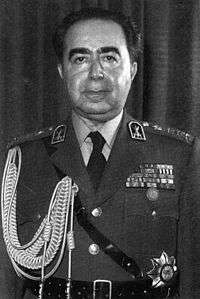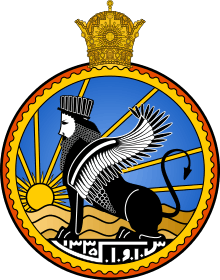Hossein Fardoust
Arteshbod Hossein Fardoust (Persian: حسین فردوست; 1917 – 18 May 1987) was a childhood friend of the last Shah of Iran, Mohammad Reza Pahlavi, and served for ten years as deputy head of SAVAK, the powerful Iranian intelligence agency.[1]

Career in SAVAK
He first developed a friendship with the young crown prince when he was permitted to attend the private school established on the grounds of the palace to instruct the sons of court favourites, and later joined the crown prince, Ali Reza Pahlavi, and Mehrpour Teymourtash when they were dispatched to the Institut Le Rosey in Switzerland for further schooling. Fardoust remained a close confidant of the Crown Prince and years later served for ten years as deputy of SAVAK, running day-to-day affairs of the security and intelligence bureau, after heading the Special Intelligence Bureau of Iran - sometimes described as a sort of "SAVAK within SAVAK" for approximately 20 years. The Special Intelligence Bureau of Iran or, in Persian daftar-dar, allowed Fardoust to be the ultimate holder of raw intel and provider of reports to the Shah of Iran. Fardoust admits to have penned down all the reported data by SAVAK, Les Deuxiume Bureau of the Army, etc. using pencil when reports of intelligence came by highest members of the intelligence community. Using pencil enabled him to manipulate and change the reports as he wished per MI6 directions. Hence as a result Shah of Iran and other members of the Senate were misinformed about every bit of information till the last moment. Khomeini was the end result and answer to the communism which the British called an Islamic Green Belt starting from Pakistan all the way to Turkey.[2]
The KGB and Hossein Fardoust
When Mohammad Mosaddegh became prime minister (April 1951), Fardoust was one of the first to leave Iran under pressure from Mosaddegh. He went to Paris and began to study law. In Paris, Fardoust turned to an iranian carpet dealer named Saberi and asked him to lend money to finance his stay in France. Saberi was a connecting link for the iranians who ended up in France and generously helped them with money. Fardoust also borrowed money from Saberi and soon made friends with him. As it turned out later, Saberi worked for the soviet KGB. If believe the information that was distributed after the revolution and related to "the work of Fardoust for the KGB", then most likely it was Saberi who recruited him.[3]
After the overthrow of the Mosaddegh's government, Fardoust returned to Iran and again became the Shah's confidant. Prime minister Fazlollah Zahedi received a reliable report from the Iranian military intelligence that Fardoust worked for foreign intelligence services. General Zahedi presented a report to the Shah, who reacted extremely negatively to the report and complained about the government, which was dismissive of his personal friend.[4]
The post of director of «Imperial Inspectorate Organization», allowed Fardoust to become the ultimate holder of raw intelligence information, which was then presented to the Shah. According to Fardoust, he recorded all the intelligence obtained from the sources of SAVAK, military intelligence, etc., with a pencil, which allowed him to manipulate and modify the reports at his discretion in accordance with the instructions of the British MI-6. Consequently, as a result, until the last, Shah and other members of the Senate were misinformed about each part of the information received.[5] According to the memoirs of the Shah’s sister, Princess Ashraf Pahlavi was convinced that Fardust was hiding vital information from the Shah, and that Fardoust even actively negotiated with Khomeini.[6]
Iranian revolution and Fardoust's position
Until the mid-1970s, Fardoust met with the Shah daily to personally inform him of the key details of intelligence reports. It is still unclear why the Shah did not want to meet in person with Fardoust two or three years before his fall. Fardoust retained his post, but now was forced to submit written reports to the Shah daily. The personal friendship that connected the Shah and Hossein Fardoust over the years has ended. Some of the most important Iranian army generals worked for some time under the leadership of Hossein Fardoust at "Imperial Inspectorate Organization", including General Abbas Gharabaghi, who in January 1979 was appointed shah by the chief of staff of the Iranian armed forces, when the monarch was forced leave Iran (January 16), and which contributed to the success of the revolution with its decision not to support the government approved by the Shah, prime minister Shapour Bakhtiar. Fardoust obviously used the last few years of his tenure to establish close ties with those generals of the Iranian armed forces who criticized the Shah and played a decisive role in the first stage of the Islamic revolution in the decomposition of the old power structures of the monarchy. The very fact that General Hossein Fardoust and General Abbas Gharabaghi survived the Islamic Revolution intact, despite the fact that they worked with the Shah for many years, is considered by many researchers as clear evidence of their involvement in the Islamic Revolution.[7] When protests against the Shah intensified in 1978, officers and politicians asked Fardoust to finally do something to stop Khomeini, to which Fardoust said: “It is completely useless to do anything. The Shah has long broken the law. It is time for him to paid the price for it".[8]
Some authors note that Fardoust played an important role in the return of Ayatollah Khomeini from emigration and in driving the Shah’s military and security personnel to the side of the revolutionaries.[9][10] It was Fardoust who urged General Gharabaghi not to suppress the revolution by force.[11]
Despite the high and important posts that he held under the shah’s regime, and his close relations personally with the shah, Fardoust remained in Iran after the overthrow of the monarchy. He was arrested, was in prison for some time, but, to everyone's surprise, he was not sentenced to death. According to the most common information, Fardoust actively cooperated with the Islamic regime,[12] founded and until 1985 was the head of SAVAMA, the new security organization and secret police, which became the successor of SAVAK.[13]
In 1985, General Fardoust was removed from all posts and imprisoned in December, where he was charged with cooperation with the KGB of the USSR.[14][15]
Last years
In April 1987, Fardoust appeared in public for the first time in a television "interview" with Islamic authorities. He described and denounced the life of the Shah, his court, and the corruption and dependency of the government he had served in.
In the interview he claimed 10,000 full-time investigators were needed by the Special Intelligence Bureau just to keep track of the money-grabbers and plunderers in the Shah's elite. `There was no way of keeping track of lesser crooks`. The marriage and then the divorce of the Shah to Princess Fawzieh of Egypt was arranged by the British.[16] According to Ervand Abrahamian, the television interview, as with all other television interviews of prisoners in the Islamic Republic, should be taken with a grain of salt.[17]
Three weeks after the interview appeared, the government announced that Fardoust had died from `old age and other natural causes.[18]
Posthumously memoirs
Three years after his death a newspaper run by the government, Kayhan-e Hava'i, ran a series of articles in both Persian and English of what were purported to be Fardoust's more detailed memoirs.[17]
The book, entitled Khaterat-e Arteshbod-e Baznesheshteh Hossein Fardoust (The Memoirs of Retired General Hossein Fardoust), expanded on the themes of corruption and conspiracy in the Shah's court and government. The book alleges that foreign imperial powers, especially Britain, dominated Iran and nourished the Freemasons the Bahá'ís and the Jews—which the book claims most Iranian politicians belonged to the Freemasons and that the Jews, controlled "not only Israel but also the United States." Another surprising fact Fardoust—or the book credited to him—claimed to reveal was that celebrated nationalist Iranian Prime Minister Mohammad Mossadeq was not a mortal enemy of the British, but had "always favored" them, and his campaign to nationalize the British Anglo-Iranian Oil Company, today known as BP, had been inspired by `the British themselves.[19]
Sources
- Abrahamian, Ervand, Tortured Confessions, (University of California Press, 1999),
Abdollah Shahbazi has published many books and articles, including "Rise and Fall of the Pahlavi dynasty." The two-volume set contained the controversial memoirs of General Hussein Fardoost, the head of Mohammad Reza Shah's secret service. Hussein Fardoust, did not remain for very long at the head of SAVAMA: in December 1985, he was accused of being a Soviet agent who was duly paid by the KGB and was stripped of his duties. He died two years later, apparently from a heart attack. The 2-volume Rise and Fall of the Pahlavi dynasty has been translated and can be read on the following site:
References
- stanford.edu Character as Destiny
- Abrahamian, Ervand, Tortured Confessions, (University of California Press, 1999), p. 159.
- Abbas Milani. Eminent Persians. Syracuse University Press, (2008), p. 442.
- Ibid.
- Abrahamian, Ervand. "Tortured Confessions", (University of California Press, 1999), p. 159.
- Simin Redjali. "A Symphony of Life". Xlibris Corporation, (2013), p. 289.
- Abbas Milani. Eminent Persians. Syracuse University Press, (2008), p. 442.
- Ibid., p. 444.
- Axworthy, Michael. "Revolutionary Iran: A History of the Islamic Republic". London: Penguin. (2014), p. 7.
- Hazem Kandil. "The Power Triangle: Military, Security, and Politics in Regime Change". (2016), p. 75.
- Milani, Abbas. "Eminent Persians: The Men and Women who Made Modern Iran, 1941-1979", in Two Volumes, Vol. 1. (2008), pp. 438-440.
- Le Monde (May 20, 1987): "IRAN: décès du général Fardoust, ancien chef adjoint de la SAVAK".
- "Khomeini Is Reported to Have a SAVAK of His Own"; The Washington Post, 7 June 1980, ; A1, Michael Getler.
- Robert E. Huyser. "Mission to Tehran". Harper & Row, (1986), p. 64.
- John K. Cooley. "Payback: America's Long War in the Middle East". Brassey's (US), (1991), p. 64.
- Abrahamian, Tortured Confessions, (1999), pp. 159–160.
- Abrahamian, Ervand (1993). Khomeinism: Essays on the Islamic Republic. Berkeley, CA: University of California Press. ISBN 0-520-08503-5.
- Abrahamian, Tortured Confessions, (1999), p. 159.
- Abrahamian, Tortured Confessions, (1999), pp. 160–161.
